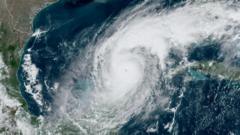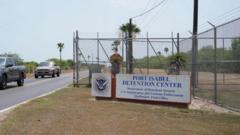The sportswear behemoth's decision to raise prices is attributed to several internal and external factors, including ongoing tariff uncertainties stemming from Trump's trade policies. While Nike didn't explicitly cite tariffs as the reason for the increases, they affect nearly all its goods produced in Asia. Prices for select shoes will increase by as much as $10, with clothing and equipment prices set to rise between $2 and $10.
Nike Plans Price Hike Amid Tariff Uncertainties

Nike Plans Price Hike Amid Tariff Uncertainties
Nike has announced a price increase on various products starting June 1, following signals from competitors about cost hikes due to U.S. tariffs.
Nike's latest pricing adjustments come amidst a backdrop of fluctuating tariffs and challenges in the U.S. retail market, prompting concerns among companies about potential impacts on consumer demand.
Nike has announced that it will be raising the prices of certain footwear and apparel beginning June 1. The decision comes shortly after Adidas also signaled potential price hikes due to ongoing trade tariffs imposed by the U.S. government.
Sources indicate that Nike's price adjustments result from a mix of internal considerations and external market factors. While the company did not directly attribute the increases to tariffs, most of its products are manufactured in Asia, which has faced increased tariffs under Trump's administration. Although higher reciprocal tariffs have been temporarily suspended until July, a standard base tariff of 10% is still in effect.
Starting June 1, Nike's shoes that cost more than $100 will see a potential price increase of up to $10, while clothing and equipment will see increases ranging from $2 to $10. Notably, popular models such as the Air Force 1 trainers and products priced under $100, as well as children’s items and Jordan merchandise, will not be affected.
Adidas recently echoed similar concerns, revealing that tariffs would likely lead to price increases for its popular shoe models, such as the Gazelle and Samba. Meanwhile, JD Sports has raised alarms that such price hikes could negatively affect customer demand in the U.S. market.
The ongoing uncertainty regarding tariffs imposed by the Trump administration has created challenges for companies worldwide. Initially announced in April, tariffs targeting products from countries like Vietnam, which represents a significant manufacturing base for Nike, range considerably in scale, complicating the pricing landscape for many retailers.
Nike, which reported a significant slump in its digital sales across all regions, has also announced a move to sell products directly on Amazon for the first time since 2019, hoping to revive online sales amid falling figures.
As U.S. trade policies continue to evolve, it remains to be seen how these price adjustments will impact Nike’s relationship with consumers and the broader market.
Nike has announced that it will be raising the prices of certain footwear and apparel beginning June 1. The decision comes shortly after Adidas also signaled potential price hikes due to ongoing trade tariffs imposed by the U.S. government.
Sources indicate that Nike's price adjustments result from a mix of internal considerations and external market factors. While the company did not directly attribute the increases to tariffs, most of its products are manufactured in Asia, which has faced increased tariffs under Trump's administration. Although higher reciprocal tariffs have been temporarily suspended until July, a standard base tariff of 10% is still in effect.
Starting June 1, Nike's shoes that cost more than $100 will see a potential price increase of up to $10, while clothing and equipment will see increases ranging from $2 to $10. Notably, popular models such as the Air Force 1 trainers and products priced under $100, as well as children’s items and Jordan merchandise, will not be affected.
Adidas recently echoed similar concerns, revealing that tariffs would likely lead to price increases for its popular shoe models, such as the Gazelle and Samba. Meanwhile, JD Sports has raised alarms that such price hikes could negatively affect customer demand in the U.S. market.
The ongoing uncertainty regarding tariffs imposed by the Trump administration has created challenges for companies worldwide. Initially announced in April, tariffs targeting products from countries like Vietnam, which represents a significant manufacturing base for Nike, range considerably in scale, complicating the pricing landscape for many retailers.
Nike, which reported a significant slump in its digital sales across all regions, has also announced a move to sell products directly on Amazon for the first time since 2019, hoping to revive online sales amid falling figures.
As U.S. trade policies continue to evolve, it remains to be seen how these price adjustments will impact Nike’s relationship with consumers and the broader market.




















